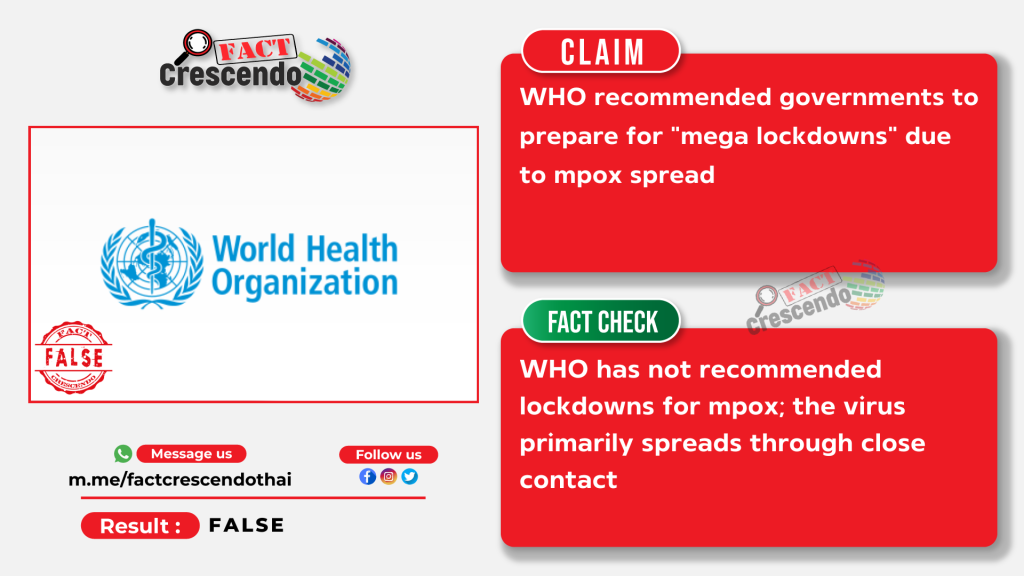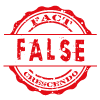
On August 20, the World Health Organization (WHO) declared a global health emergency due to the mpox virus. This new outbreak is caused by a different strain, clade I, compared to the clade II strain responsible for the 2022 emergency. The WHO’s declaration aims to raise awareness and prompt international action to control the virus’s spread (Source).
Meanwhile, a claim has been circulating on social media and various websites asserting that the WHO has ordered governments to prepare for “mega lockdowns” due to the spread of mpox (formerly known as monkeypox).
Social Media Claim
Recently, multiple social media users shared messages claiming that the WHO declared governments should prepare for “mega lockdowns” due to the spread of the mpox virus. This claim has been circulating on various platforms, including Facebook and X.
Fact-Check
Upon our investigation, it was revealed that, as of today, the WHO has not issued any declarations regarding lockdown preparations. While the WHO has declared mpox a public health emergency of international concern due to its spread in certain regions, it has not recommended lockdowns as a measure to control the disease. Mpox primarily spreads through close, skin-to-skin contact, making it less likely to cause a pandemic compared to airborne diseases like COVID-19
The Fact Crescendo team reached out to the WHO office in Thailand for clarification. They confirmed, “The recommendations from WHO are publicly available and don’t include any lockdown.” Detailed information about mpox from the WHO can be found here.
Apart from the viral claim of mega lockdowns, we also found an image purportedly showing an mpox patient circulating on social media (here and here). After tracing the picture’s origin using reverse image search, we discovered that the image dates back to October 2022 and was taken by a Mexican doctor. The doctor clarified that while this patient was infected with monkeypox, he was also immunocompromised (had a weakened immune system). Therefore, the claim that this image represents the most recent strain of mpox is misleading.
Differences Between The Clade I And Clade II Strains Of The Mpox Virus
Mpox virus is categorized into two main clades: Clade I and Clade II. Clade I, primarily found in Central Africa, is known for causing more severe illness and higher mortality rates, with some outbreaks resulting in up to 10% fatality. This clade is typically associated with zoonotic transmission, primarily from rodents, and has limited human-to-human spread. In contrast, Clade II, which includes subclades IIa and IIb, is less virulent and has a lower mortality rate. Clade IIb was responsible for the global outbreak that began in 2022, spreading more efficiently through human-to-human contact.
Key Differences:
- Severity: Clade I causes more severe disease and higher mortality rates compared to Clade II.
- Transmission: Clade I is mainly zoonotic with limited human-to-human spread, while Clade II, especially Clade IIb, spreads more efficiently between humans.
- Geographic Distribution: Clade I is endemic to Central Africa, whereas Clade II has been responsible for outbreaks in West Africa and globally.
The World Health Organization (WHO) has outlined several preventive measures to control and prevent the spread of mpox (formerly known as monkeypox). Here are the key recommendations:
- Vaccination: WHO recommends vaccination for people at high risk of mpox, especially during outbreaks. The vaccine should ideally be administered within 4 days of exposure to someone with mpox, but it can still be effective if given within 14 days, provided there are no symptoms.
- Avoid Close Contact: Mpox spreads through close contact, including sexual contact. Avoiding close contact with infected individuals and practicing safe sex can reduce the risk of transmission.
- Hygiene Practices: Regular handwashing with soap and water or using an alcohol-based hand sanitizer can help prevent the spread of the virus. Disinfecting surfaces and objects that may be contaminated is also important.
- Isolation: Infected individuals should be isolated from others to prevent the spread of the virus. This includes staying at home and avoiding public places until fully recovered.
- Use of Personal Protective Equipment (PPE): Health workers and caregivers should use appropriate PPE, such as gloves and masks, when caring for infected individuals to prevent transmission.
- Public Health Measures: Health authorities should conduct contact tracing, provide clear communication about the risks and preventive measures, and ensure access to medical care and vaccines.
Summary
The WHO declared a global health emergency for the mpox virus, caused by a new strain, clade I. Despite social media claims of “mega lockdowns,” the WHO has not recommended such measures, confirming that mpox primarily spreads through close contact. Key preventive measures include vaccination, avoiding close contact, hygiene practices, isolation of infected individuals, and the use of personal protective equipment.
Source:
PNAS: Genomic epidemiology of the 2022 monkeypox virus outbreak
Johns Hopkins Bloomberg School of Public Health: Mpox Situation Update
WHO: Strategic Framework for Enhancing Prevention and Control of Mpox
WHO: Strategic Framework for the Prevention and Control of Mpox





